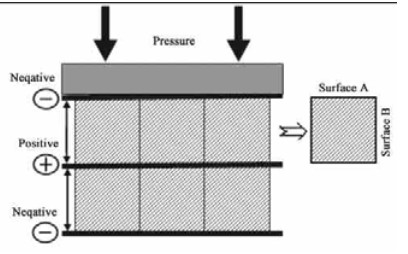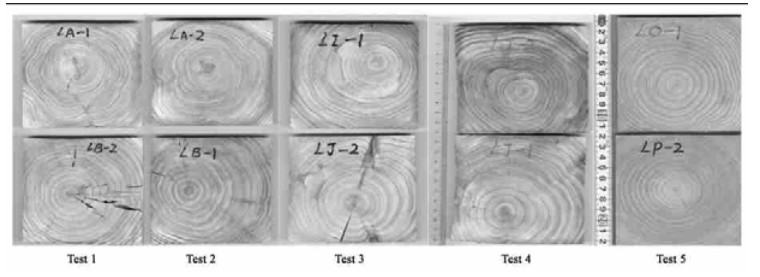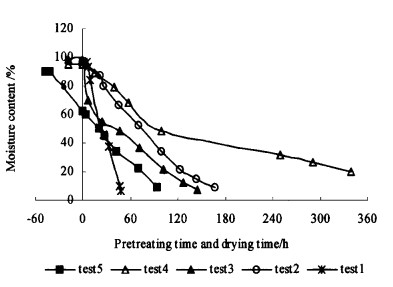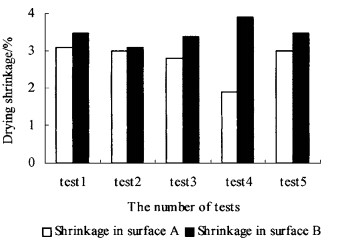文章信息
- Li Xiaoling, Kobayashi Isao, Kuroda Naohiro, Gao Ruiqing
- 李晓玲, 小林功, 黑田尚宏, 高瑞清
- Study on RF/V Drying and Check Preventing for Japanese Sugi
- 日本柳杉高频真空干燥及防止开裂的研究
- Scientia Silvae Sinicae, 2005, 41(2): 106-111.
- 林业科学, 2005, 41(2): 106-111.
-
文章历史
Received date: 2004-10-10
-
作者相关文章
2. 日本森林综合研究所 茨城县 305-8687
2. Forestry and Forest Products Research Institute, Japan Ibayaki 305-8687
Sugi (Cryptomeria japonica) is the main plantation species that occupies 45% of the planted areas in Japan (Hisada, 2001). The main use of this species is for the material of post and beam in wooden house. In order to prevent the generation of troubles after the house completed, it is necessary to use high-quality dried timber. But in practical production, drying Sugi is a very difficult project. One reason is that Sugi timber for construction material usually contains the pith (boxed-heart) with large cross-section, another reason is that the range of moisture content (MC) of green Sugi timbers is very diverse, generally from 50% to 250%. All these reasons make it difficult to get the high drying quality with little drying checks and uniform final MC after drying. As we know, radio frequency/vacuum (RF/V) drying is a fast drying method especially for valuable and large-size timber but takes high cost. So the aim of this research is to investigate the reasonable RF/V drying conditions that can make the boxed-heart timber of Sugi dry quickly and have high drying quality.
The RF/V drying technology combines two special drying methods together. One method is to employ the vacuum drying that causes rapid evaporation of surface moisture at low temperature, another method is to employ the radio-frequency (RF) current heating. The energy of RF waves is being dissipated to high degree in the timber causing heat because of the molecular friction of the water molecules. The heat will make the moisture of lumber move quickly from inside of lumber to its surface (Resch et al., 2001). In Japan many research work about this combined drying method have been done for many years, but drying boxed-heart timber of Sugi is still keeping on the research step, because there have some problems such as heave drying checks, high drying cost.
The main purpose of this research work is to obtain RF/V drying technology and drying characteristics on boxed-heart timber of Sugi and at the same time clarify the method how to reduce the drying checks during RF/V drying process.
2 Material and methods 2.1 MaterialThe species of tests is Japanese Sugi. The dimension of samples was 1 200 mm × 114 mm × 114 mm. The range of initial MC was from 50% to 160%, the average basic density was 0.35 g·cm-3.
All the tests were conducted in wood drying laboratory of Forestry and Forest Product Research Institute in Japan. The main equipment is RF/V test dryer typed as SB-900. The maximum pressure and volume of chamber are 0.049 MPa and 1.655 m3 respectively. This RF/V dryer consists of six parts that are radio-frequency (RF) applicator system with the frequency of 6.7 MHz, vacuum system, cooling system, electric controller system, steaming pretreatment system and oil cylinder pressure system.
About RF applicator system, there are three different voltages (written as EI) of input power that can be chosen as 4 kV, 5.1 kV and 6.2 kV. The range of the current of input power (written as IP) is 0.2~0.8 A. Both of the maximum oscillation on time and oscillation off time are 3 min. The working principle of RF heating system is showed by following formula.

|
(1) |
EI: the voltage of input power of RF applicator system, kV; IP: the current of input power of RF applicator system, A; T1: oscillation on time, min; T2: oscillation off time, min; P: input power of RF applicator for per cubic lumber, kW·m-3; 60%: the efficiency of RF applicator system for SB-900 dryer; V: the total samples volume for test, m3.
2.2 MethodsBefore starting the tests, every two samples with length of 1 200 mm were cut from one 3-meter-long lumber shown as Fig. 1, and the initial MC slices and density slices were cut at the same time. Sample S1 and sample S2 were considered to have the same properties and were used for the comparison tests. The initial MC slice was cut into seven pieces to measure initial MC distribution, as shown in Fig. 1.

|
Fig.1 Sample, MC and density slice cutting |
When starting each test, six samples were taken out from cooling storage, and the initial data about weight, width, length and initial checks were taken from every sample. Then, the samples were stacked in RF/V chamber as shown in Fig. 2.

|
Fig.2 The stack of test |
During the drying process, the samples were weighed and at the same time drying checks were also measured one time every two days in order to get the current MC and drying defects under corresponding RF/V conditions which are shown in Tab. 1. The test was finished when the estimated finial MC reached 15%, and then the final test data about weight, width, length and drying checks of every sample were taken. After then, one final MC slice was cut from every sample around its middle portion so as to measure the final MC and final MC distribution for every sample, and the internal checks were also observed after cutting the MC slice.
|
|
When the test was finished, the drying quality was evaluated in terms of drying checks, average final MC and final MC distribution, shrinkages and drying rate. The rationality of RF/V drying conditions for every test was also evaluated at the same time, and then the ideas to improve the drying quality were put forward. In this series of research tests, steaming pretreatment and superheated-steaming pretreatment were adopted to improve RF/V drying quality for Sugi boxed-heart lumber.
3 Results and discussionsFive tests were conducted in this research work. The tests results and their corresponding RF/V drying conditions were shown in Tab. 1, and their drying qualities were evaluated according to drying checks, final MC distributions, drying rates and shrinkages.
3.1 The drying checksAccording to RF/V conditions listed in Tab. 1, test 1 was conducted under the same absolute pressure under vacuum (APV) of 0.008 MPa as test 2, but adopted much stronger power supply of 10 kW·m-3 than in test 2.
The results showed that, even though some surface checks occurred in test 2, but no internal checks did. In test 1 there were some internal checks and the surface checks were more severe than in test 2 as shown in Fig. 3. Therefore the test 3, which had the same RF/V conditions as test 2, and additional 90 ℃ steaming pretreatment for 19 h, was conducted after test 2. The results of test 3 showed that, even though there were still some surface checks occurred during the drying process, the degree of drying checks was reduced compared with test 2. In order to reduce the drying checks in a higher level, the test 4 which had the same RF conditions, but higher APV of 0.05 MPa was conducted after test 3. The results of test 4 showed that, the degree of drying checks was reduced much more than test 3, but the drying rate was very low. After test 4, test 5 was conducted with the same RF/V conditions as test 3 and with superheated-steaming pretreatment. The superheated-steaming pretreatment conditions were set as: steaming at 115 ℃ for 6 h and superheated-steaming at 115 ℃ for another 42 h, meanwhile the relative humidity (RH) was set gradually decreasing from 100% to 83% within 42 h. As the result, the average MC of samples for test 5 was reduced from 90.1% to 64.8% after 48 h pretreatment. The results of test 5 showed that the degree of drying checks was a little more serious than test 4, but lighter than test 3, and in addition, the drying rate of test 5 was three times faster than test 4. Considering all tests results synthetically, the RF/V drying conditions for test 5 are relatively better than those for other tests, even if there still have some drying checks in test 5. The main reason for this change is that steaming and superheated-steaming pretreatment make the efficient effect for reducing the drying checks, as some researchers have reported (小林功等, 2003; Cheng et al., 2002).

|
Fig.3 The scanning of cross-section for samples after drying |
In test 5, the samples were pretreated with steaming and superheated steaming of 115 ℃ that is much higher than the lignin softening point of Sugi wood(about 80 ℃). As the superheated-steaming pretreatment goes on, the moisture of surface layer evaporates first, and when its moisture content decreases below FSP, the surface layer begins to shrink, and then tension stress in surface layer is caused. It is known that wood characterize the viscoelastic property, and under high temperature and high humidity, wood will be more viscous than under lower temperature, so even there are some tension stress in the surface layer, it can not be kept strong enough to cause surface checks, and some proportion of drying stress will be absorbed by the creep of wood. Therefore, in test 5, after the superheated-steaming treatment, not only the average MC of samples were decreased, but also thin layer of surface drying sets were formed, thus during the follow-up RF/V drying, less surface check occurred. In Japan, using high temperature drying is one of the practical methods to reduce Sugi drying checks.
3.2 The moisture content distributionThe average final MC of dried construction lumber in Japanese market is around 15%. But the initial MC of Sugi species is very diverse, the heartwood is generally in a wide range of 50% to 150% and sometimes reaches 250%, while that of sapwood is around 150% to 250% (Hisada, 2001). For these reasons, Sugi boxed-heart lumber is difficult to be dried to low and uniform final MC in short time. RF/V drying method is one of the efficient ways to solve this problem. After all the drying tests, the results of five tests showed that, the final MC distributions of six samples in different site of stack were even in any test. In this paper, the distributions of initial MC and final MC for six samples of test 1 and test 5 were shown in Fig. 4 and Fig. 5. The results were shown that even if the initial MC for six samples in different site of stack were very different, all the curves showed that the final MC were more uniform in every sample after RF/V drying.
In Japan, some wood drying factories usually presort Sugi lumbers according to their weight before drying, so that the timbers with little difference in initial MC will be dried in the same kiln, and at the same time more dried timbers with even final MC will be gotten.
3.3 The drying rateFrom the results shown in Tab. 1 and Fig. 6, it is observed that the drying rates of five tests are different under different RF/V drying conditions. The drying rate of test 1 is the highest one, and the drying rate of test 4 is the lowest one. Because it is known that when the drying process is running under RF/V drying conditions, the high vacuum pressure causes rapid evaporation of surface moisture at low temperature and at the same time the high energy of RF heating makes the moisture move quickly from internal of lumber to its surface (Resch et al., 2001). As a result drying process will be shortened by high vacuum pressure and strong power supply. About other three tests, the drying rate of test 5 was a little higher than test 3, and test 3 is a little higher than test 2, but these three drying rates were not so different in the MC range under 60%. It is known that drying rate is not only affected by RF/V drying conditions but also by drying pretreatment conditions. The high temperature steaming and superheated-steaming pretreatment were expected to quick the drying process, because the moisture movement is observed to increase along with the increase of steaming temperature and pressure (Oliveira et al., 2001) and it is speculated the permeability of wood to increase under high-temperature and high-pressure steaming (Ishikawa et al., 2001) In this research, the drying rates were not to be affected too much but the drying time was shortened by the pretreatment.

|
Fig.6 Drying rates for five tests In Fig. 6, on the X axis, "0" to "-60" shows the pretreatment process, and "0" to "360" shows RF/V drying process. |
The results of average drying shrinkages of samples on surface A and surface B for five tests were shown in Fig. 7.

|
Fig.7 The drying shrinkage on surface A and surface B |
It is shown that, the average drying shrinkages of both surfaces were not too serious for every test, but the drying shrinkages on surface B were little more severe than those on surface A, the range are from 3.1% to 3.8% and 1.9% to 3.2% respectively. The reason for this difference was considered that during the RF/V drying process, there was a stable cylinder pressure from top of chamber pressed on the stack to reduce the drying deformations, as a result, surfaces B of samples were pressed during all the drying process.
In Fig. 7, the average drying shrinkages on both surfaces for test 4 was shown to be more different from other tests, that was, the average shrinkage on surface B was more severe than it of other tests, and on the contrary, the average shrinkage on surface A was lower than it of other tests, the main reason was estimated that tests 4 lasted longer time, and as a result, direction B of samples will be pressed to shrink for long time, and the final MC of test 4 was higher than those of other tests, the shrinkage on surface A will increase along with the MC decreasing.
4 ConclusionsRF/V drying method is the efficient and fast drying method for boxed-heart timber of Japanese Sugi, but drying quality is different under different RF/V drying conditions. Strong power supply and high vacuum pressure can shorten the drying process but more checks occurred at the same time. High temperature steam (higher than 90 ℃) and superheated-steaming pretreatment is one of the efficient ways to reduce RF/V drying check and quick the drying process.
The MC of green Sugi is very diverse, in this research work, the range of initial MC of samples for each test are from 55% to 200%, but all tests results showed that the final MC are uniform after drying under their corresponding RF/V conditions.
The drying rate of RF/V drying method is not only affected by RF/V drying conditions but also by pretreatment conditions. When the drying process is running under RF/V conditions, high vacuum pressure causes rapid evaporation of surface moisture at low temperature and at the same time the high energy of RF heating makes the moisture move quickly from internal of lumber to its surface, and in addition, high temperature steaming and superheated-steaming pretreatment was effective in shortening of the drying process.
Drying shrinkages of samples in five tests are different on surface A and surface B, but they are not too serious, shrinkages on surface B are little more severe than those on surface A, and the range are from 3.1% to 3.8% and from 1.9% to 3.2% respectively. The reason is direction B of samples will be pressed during the drying process.
AcknowledgementThe authors thanks are extended to JICA for its financial support on this research, and thanks also wish to reach to all helpful staffs from FFPRI especially to Tsutomu Takano, Atsuko Honda and Takahiro Yoshida.
小林功, 黑田尚宏, 久田卓兴, 等. 2003. Superheated steam pre-treatment for the drying process of boxed-heart timber from Sugi. 日本木材工业, 58(6): 258-263. |
Cheng W L, Morooka T, Norimoto M. 2002. Shrinkage stresses occurring in the drying process of wood using superheated steam. Wood Research: 25-26. |
Hisada T. 2001. Present state of the wood drying in Japan and problems to be solved. Proceedings of 7th International IUFRO Wood Drying Conference, Japan, 14-19
|
Ishikawa A, Kuroda N, Kagawa A, et al.2001.Permeability of Sugi wood under high-temperature treatments. Proceedings of 7th International IUFRO Wood Drying Conference, Japan, 412-415
|
Oliveira L C, Wallace J W, Wright D M, et al.2001.Development of superheated steam/vacuum drying schedules for Western Canadian species. Proceedings of 7th International IUFRO Wood Drying Conference, Japan, 140-146
|
Robert A H. 1984. Comparison of moisture content distribution, stress distribution, and shrinkage of red oak lumber dried by a radio-frequency/vacuum drying process and a conventional kiln. Forest Products Journal(USA), 34(1): 44-54. |
Resch H, Gautsch E.2001.High-frequency current/vacuum lumber drying. Proceedings of 7th International IUFRO Wood Drying Conference, Japan, 128-133
|
 2005, Vol. 41
2005, Vol. 41



